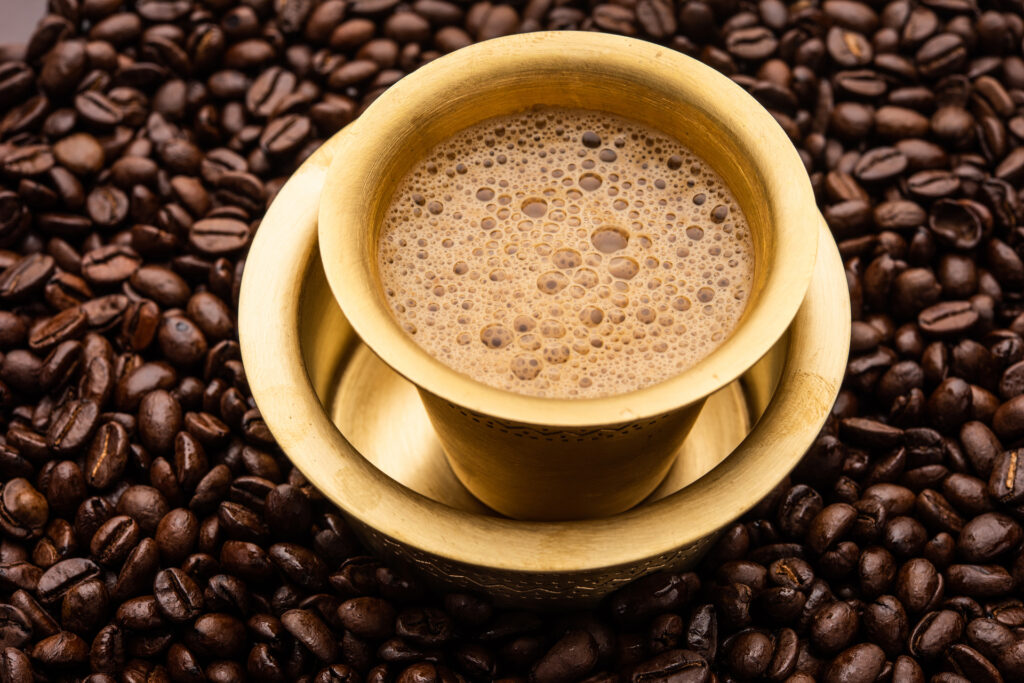
Introduction: A Brew Like No Other
Filter coffee, also known as South Indian filter coffee or “Kaapi,” is not just a beverage – it’s an experience steeped in tradition, craftsmanship, and culture. The aroma of freshly brewed coffee decoction mixed with hot milk and served in a traditional stainless-steel tumbler and Deborah has been a morning ritual in countless South Indian households for centuries. But where did this beloved brew originate, and what makes it so special? Chef Abdul, a culinary historian and coffee enthusiast, takes us on a flavourful journey through the history and artistry of filter coffee.
The Origins of Filter Coffee
The story of filter coffee begins in the 17th century when coffee first reached the Indian subcontinent. It is widely believed that an Indian Sufi saint, Baba Budan, smuggled seven coffee beans from Yemen to India during his pilgrimage to Mecca. He planted these beans in the hills of Chikmagalur in Karnataka, a region that remains one of India’s prime coffee-growing areas today.
“Coffee culture in India evolved from these humble beginnings,” explains Chef Abdul. “What began as a crop in the hills eventually became a cornerstone of South Indian culinary traditions.” By the 19th century, coffee had become a staple beverage, particularly among the Tamil, Kannada, and Telugu-speaking communities. The advent of the metal coffee filter revolutionized its preparation, giving rise to the iconic South Indian filter coffee.
What Makes Filter Coffee Unique?
Unlike instant coffee or espresso, South Indian filter coffee is a slow brew prepared with precision and patience. The distinctiveness of filter coffee lies in its three main components:
“The beauty of filter coffee is in its balance,” says Chef Abdul. “The rich aroma, smooth texture, and perfect mix of coffee and milk make it a comforting and invigorating drink.”
Chef Abdul’s Tips for Perfect Filter Coffee
Chef Abdul shares his secrets for brewing the perfect cup of filter coffee:
Filter Coffee: A Cultural Icon
Filter coffee is more than a morning pick-me-up; it’s a cultural symbol. In South India, it’s synonymous with hospitality. A steaming cup of filter coffee is the first thing offered to guests, a gesture that signifies warmth and welcome. Coffee houses in Tamil Nadu and Karnataka, such as the iconic MTR in Bangalore or Saravana Bhavan in Chennai, have elevated filter coffee to an art form.
Even beyond South India, filter coffee has gained global recognition. Cafés worldwide now feature “South Indian filter coffee” on their menus, introducing international audiences to its unique charm.
Chef Abdul’s Filter Coffee Recipe
For those who wish to recreate this traditional brew at home, Chef Abdul shares his time-tested recipe:
Ingredients:
Method:
Filter coffee is not just a drink; it’s a legacy passed down through generations. It tells the story of cultural exchange, innovation, and a shared love for coffee. Chef Abdul says, “A cup of filter coffee is like a warm hug from South India – rich, aromatic, and unforgettable.” Whether you are a lifelong coffee enthusiast or a curious first-timer, filter coffee invites you to slow down, savour the moment, and indulge in a truly unique brew.
So, why not grab a tumbler, brew a fresh pot, and experience the magic of filter coffee?
Chef Abdul © Copyright 2024. All rights reserved.